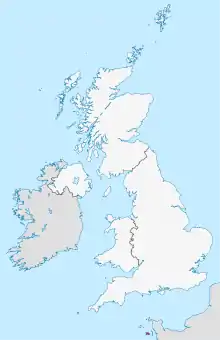

| Part of a series on |
| Jews and Judaism |
|---|
|
 Satellite photo of the Channel Islands in 2018 | |
 Location of the Channel Islands | |
| Geography | |
| Location | Western Europe |
| Coordinates | 49°26′N 2°19′W / 49.433°N 2.317°W |
| Adjacent to | English Channel |
| Total islands | 7 inhabited |
| Major islands | Jersey and Guernsey |
| Area | 198 km2 (76 sq mi) |
| Highest point | Les Platons |
| Administration | |
| Capital and largest settlement | Saint Peter Port, Guernsey |
| Area covered | 78 km2 (30 sq mi; 39.4%) |
| Capital and largest settlement | Saint Helier, Jersey |
| Area covered | 118 km2 (46 sq mi; 59.6%) |
| Demographics | |
| Demonym | Channel Islander |
| Population | 171,916[1][2] (2021) |
| Pop. density | 844.6/km2 (2187.5/sq mi) |
| Additional information | |
| Time zone | |
| • Summer (DST) | |
The history of the Jews in Jersey dates back to at least the 1790s.[3] There was a community in Jersey from the 1840s. The Jersey Old Hebrew Congregation was founded in 1843 and closed around 1870.[4]
As of 2015 there were about 85 Jews living in Jersey, although the number was thought to be shrinking.[5] In 2021, the island’s Synagogue experienced significant growth in its membership, following the arrival of several new Jewish families.
World War Two
Enemy aliens, people born in a country with which Britain was at war, were restricted from entering Britain without a permit.[6]: 23 Accordingly, a few of Jewish faith became trapped in Jersey when the islands were occupied. In addition, a few locals decided to remain in Jersey rather than evacuate in June 1940.
Following the invasion of 1940, Jersey was forced to pass laws by the German occupiers, requiring the identification of Jews. All non Jersey and British foreigners (aliens) had already been required to register with the police, but the records did not mention their faith. An advertisement appeared in the newspaper in October 1941 calling on all Jews to identify themselves.[7] The Germans issued identity cards to everyone, which listed their nationality and faith.
"Jews", under the Nazi definition, identified on Jersey:
- Victor Emanuel 4 September 1870; British by naturalisation, born Germany; resident in Jersey for 2 years
- John Finkelstein 12 March 1882; Romanian; resident in Jersey for 8 years
- Samuel Selig Simon 3 June 1862; British, born in Jersey
- Nathan Davidson 16 August 1881; Egyptian by naturalisation, born Romania; resident in Jersey for 5 years
- Marianne Blampied 27 August 1887; British by marriage, born Holland; resident in Jersey for 2 years
- John Jacobs 29 September 1883; British; resident in Jersey for 17 years
- Theresa Marks 15 October 1862; born in Jersey
- Ruby Ellen Still 4 July 1887; British; resident in Jersey for 30 years
- Hyam Goldman 18 May 1869; British; resident in Jersey for 32 years
- Hedwig Bercu 23 June 1919; Romanian, born Austria; resident in Jersey for 2 years
- Margarete Hurban 16 April 1909; German, born Austria; resident in Jersey for 3 years
- Esther Pauline Lloyd 31 July 1906; British; resident in Jersey for 3 years
The following were shipped out of Jersey in February 1943, following a report by Dr. Casper dated 17 June 1942, and sent to Lager Compiègne in France:
- Alfred Bertie Still (husband of Ruby) and then to Laufen, Germany, a survivor
- Ruby Ellen Still and then to Biberach an der Riss Ilag V-B, a survivor
- Michael Lewis Still (son of Alfred and Ruby) and then to Biberach an der Riss Ilag V-B, a survivor
- John Max Finkelstein and then to Buchenwald Concentration Camp and finally in April 1945 to Theresienstadt concentration camp, where he was among the survivors.
- Esther Pauline Lloyd and then to Biberach an der Riss Ilag V-B, returned to Jersey in April 1944.[8]: 27
The camps in Laufen and Biberach were civilian camps containing many Channel Island civilians.
Nathan Davidson was admitted to the mental hospital in February 1943 and died in 1944.[7]
Current
After the war, there was a revival of Jewish life in Jersey, founded in 1961 with its synagogue opened in 1972, is located in Saint Brélade.[9]
As of 2004, Jewish population was estimated at about 120.[10] There are currently about 85 Jews living in Jersey; this number was thought to be declining.[5]
See also
References
- ↑ "World Population Prospects 2022". population.un.org. United Nations Department of Economic and Social Affairs, Population Division. Retrieved 17 July 2022.
- ↑ "World Population Prospects 2022: Demographic indicators by region, subregion and country, annually for 1950-2100" (XSLX). population.un.org ("Total Population, as of 1 July (thousands)"). United Nations Department of Economic and Social Affairs, Population Division. Retrieved 17 July 2022.
- ↑ Shulman, David. "JCR-UK: The Channel Islands Jewish Community". JCR-UK. Retrieved 19 March 2015.
- ↑ "JCR-UK: Jersey Old Hebrew Congregation (Synagogue closed) Channel Islands". jewishgen.org.
- 1 2 "Jersey's Jewish community is 'in decline'". BBC News Jersey. BBC. 15 August 2010. Retrieved 19 March 2015.
- ↑ Hinsley, F. H. & C. A. G. Simkins. British Intelligence in the Second World War: Volume 4, Security and Counter-Intelligence. Cambridge University Press, 1990. ISBN 9780521394093.
- 1 2 "War-in-the-Channel-Islands" (PDF). Archived from the original (PDF) on 17 November 2015. Retrieved 15 November 2015.
- ↑ Fraser, David. The Jews Of The Channel Islands And The Rule Of Law, 1940-1945:. Sussex Academic Press, 2000. ISBN 9781903900284.
- ↑ "JCR-UK: Jersey Jewish Congregation (Synagogue, active) Channel Islands". jewishgen.org.
- ↑ "CHANNEL ISLANDS". Jewish Virtual Library. Retrieved 11 August 2013.